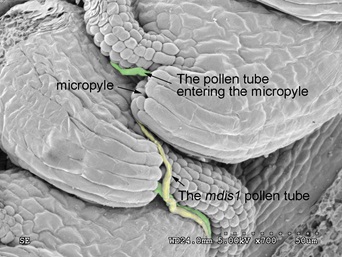Sexual reproduction requires recognition between the male and female gametes. In animals, the sperms swim to the egg lured by the egg-derived chemotropic signals. While for angiosperms, the most prosperous species on earth, the sperm cells are immobile, thus the pollen tube, a sperm-delivery structure, is evolved. Through polar growth, the pollen tubes deliver the two sperm cells to the ovule-enclosed female gametophyte embedded in the pistil. During the long journey in the pistil, the pollen tubes are guided by female signals to precisely target the micropylar opening where the receptive synergid cells located. The synergid cells secret peptide signal LURE1, a defensin-like peptide, to attract the pollen tubes, while it is long-puzzled that how pollen tubes sense this peptide signal to achieve directional growth.
A team led by Dr. YANG Weicai of the State Key Laboratory of Molecular Developmental Biology, Institute of Genetics and Developmental Biology (IGDB), Chinese Academy of Sciences, recently reported the identification of a cell-surface receptor heteromer, MDIS1–MIK, on the pollen tube that perceives the female attractant LURE1 in Arabidopsis thaliana. Genetic analysis shows that the mutants of mdis1, mik1 and mik2 less efficiently target the micropyle and the purified LURE peptide-embedded micro-beads. MDIS1, MIK1 and MIK2 are plasma-membrane-localized receptor-like kinases with an intracellular kinase domain and extracellular domain which specifically bind LURE1. Biochemical results show that these three receptors form a complex with LURE in plants.
In plants, after perception of ligand, the receptor kinases often trigger cellular response through activation of co-receptors. Biochemical results show that LURE1 triggers dimerization of MIK and MDIS1 and trans-phosphorylation, suggesting a phosphorylation–dependent signal transduction pathway in male-female perception.
The pollen tube guidance process is a premise for successful fertilization, but also acts as a vital reproduction isolation barrier preventing inter-species crossing. To test if MDIS1 perceive the female attractants and contribute to reproduction isolation, it was expressed in Capsella rubella, the sister species of Arabidopsis. Remarkably, transformation of AtMDIS1 to the sister species Capsella rubella can partially break down the reproductive isolation barrier.
This finding identified the long-puzzled receptor heteromer of the LURE1 attractant and revealed the activation mechanism and will contribute to the full understanding of male-female recognition during plant reproduction. Meanwhile, this study establishes the theory of through inter-species expressing of receptor to break down the reproductive isolation and will shed light in the crop breeding.
The work entitled “A receptor heteromer mediates the male perception of female attractants in plants” was published on
Nature on Feb 11, 2016 (
doi:10.1038/nature16975).
This research was supported by the grants from Ministry of Science and Technology of China and the National Natural Science Foundation.
Pollen tube guidance at the micropyle. (Image by IGDB)
Contact:
Dr. YANG Weicai and Dr. LI Hongju
E-mail: wcyang@genetics.ac.cn or hjli@genetics.ac.cn
 Pollen tube guidance at the micropyle. (Image by IGDB)Contact:Dr. YANG Weicai and Dr. LI HongjuE-mail: wcyang@genetics.ac.cn or hjli@genetics.ac.cn
Pollen tube guidance at the micropyle. (Image by IGDB)Contact:Dr. YANG Weicai and Dr. LI HongjuE-mail: wcyang@genetics.ac.cn or hjli@genetics.ac.cn CAS
CAS
 中文
中文




.png)
